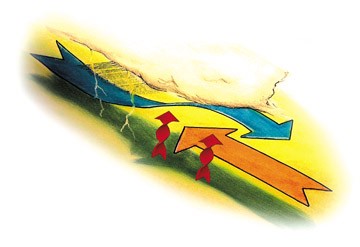
Tornadoes make Texas touchdown
Anyone who has taken a bath has seen the fundamentals of a tornado. When the drain is pulled in a bathtub, the downward water flow accelerates and forms a vortex. This same phenomenon is seen in one of nature’s most violent acts, a tornado.
The National Weather Service defines tornadoes as “a violently rotating column of air, in contact with the ground and pendant from a thunderstorm.”
Because a tornado originates from a thunderstorm, it requires air abundant with low-level moisture to form. This warm, moist air is pulled up into the storm, a process known as uplift. It is within the uplift that a tornado is born.
As the moist air moves upward, it begins to rotate quickly, generally due to the collision of warm and cool air streams. As the swirling motion gains strength, a tornado winds down from the storm like a “huge, swirling rope of air,” according to the National Weather Service’s Web site.
The path of a twister is controlled by the direction of its parent thunderstorm cloud. When in contact with the ground, the force of a twister can lift nearly anything in its path hundreds of feet into the air, hurling it yards away. However, if the vortex of the tornado is disturbed, it will lose contact with the ground, causing no damage. The disruption of the vortex causes tornadoes to “skip” along the ground.
Twisters vary in terms of size and intensity, typically fitting into one of three categories – weak, strong and violent storms.
Weak tornadoes have a thin, rope-like appearance. Winds do not exceed 110 mph and the twister’s lifetime is between one and 10 minutes. Seven of 10 tornadoes are categorized as weak.
Strong tornadoes are characterized by the classic funnel shape cloud. Wind rotates in an updraft between 110 and 200 mph, with the disturbance often lasting more than 20 minutes.
Violent storms make up less than 2 percent of all tornadoes. Yet, violent tornadoes account for 70 percent of all tornado fatalities. Winds can reach over 200 mph and are capable of mass destruction. Violent twisters can last more than an hour.
All areas of the United States are susceptible to tornadoes. However, they occur more frequently in certain regions of the country. Oklahoma, Kansas and Texas experience the highest concentration of twisters in the country. Due to the state’s frequency of storms, Florida is also hit often. The Plains area, known as “tornado alley” is home of the nation’s most violent storms. The geography of the area favors the formation of the largest and most dangerous tornados.
Within Texas, twisters are most likely to occur between 3-9 p.m., generally moving southwest to northeast about 30 mph.








